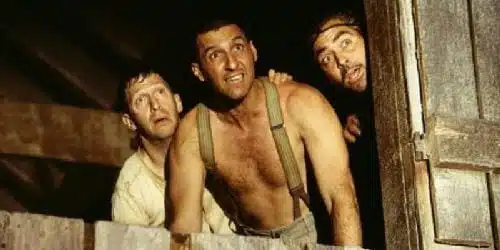
When you think about it, O Brother, Where Art Thou? was actually the Coen Brothers first legitimate commercial hit. Before then, the boys had been banished to the backburner of mainstream fame. Fargo had earned them Oscar acknowledgement and The Big Lebowski would go on to become a massive cult favorite, but your everyday moviegoer didn’t give the guys credit until they combined George Clooney with good timey country music to give Southern Americana their own arch interpretation. The talented TV star, still struggling to find fame outside a hospital setting, rode O Brother to much bigger if questionably better things. As for the men behind the monster, they fell into a kind of funk, following this Grammy winning work with The Man Who Wasn’t There and then two decidedly lesser entries – Intolerable Cruelty and The Ladykillers.
Yet it was O Brother that brought the otherwise uninitiated into the Coen fold. The story, supposed based around the epic poem The Odyssey by Homer, features Clooney as Ulysses Everett McGill. He’s a swarthy fast talking chain gang convict who convinces his pals Pete (John Turturro), and Delmar O’Donnell (Tim Blake Nelson) to escape the prison farm. Their goal – recover a $1.5 million treasure that Everett buried in a nearby valley. Unfortunately, the area is earmarked for flooding as part of a dam/hydroelectric project.
As they journey toward their goal, the trio run into a Church congregation on its way to a baptism, the notorious bank robber George “Baby Face” Nelson (Michael Badalucco), a group of sirens, and a burly Bible salesman (John Goodman). They also record a song – “Man of Constant Sorrow” as the ‘Soggy Bottom Boys’, which in turn becomes a massive regional hit. Before long, they become involved with Everett’s wife (Holly Hunter) and the campaign for Governor between incumbent Pappy O’Daniel (Charles Durning) and his questionable competition, Homer Stokes (Wayne Duvall).
Like a needlepoint sampler made out of machismo and mountain oysters, O Brother, Where Art Thou? is a brilliant slice of period piecemeal magnificence. It’s funny, fresh, and yet somehow familiar. It’s a road movie without the motor, an episodic descent into a world of pixies, politicians, and possibilities. With their script, honed to perfection and filled with the kind of weird witticisms the Coens are known for, we enter a parallel time and place that offers recognizable riffs while playing possum with the presets of the genre. It’s not a musical per se, though the folk and bluegrass tunes of the time permeate the scenery like the smell of corn silk on farmland Summer’s eve.
Additionally, the Coens use the interludes to underline the various themes in the film. Whether it’s seduction or silliness, the traditional melodies measure out a kind of destiny that Everett and his cronies constantly challenge and chase. A perfect example of this is during the first act, when Pete and Delmar get “saved.” As the standard spiritual moves between the trees, O Brother strings spirituality and the debt owed to society and the state as motivation for these men’s actions. Similarly, when the integrated nature of Soggy Bottom Boys is discovered, the power of their performance actually turns public policy. Like using the obvious visual cue of riding someone out on a rail, O Brother believes in the obviousness of its olds school ways.
They also have some significant acting help in the process. Practically unknown before, Tim Blake Nelson almost steals the film away from his celebrated betters. Ever line that comes from Delmar’s mouth seems shaded in colors of naiveté and nonsense. During a middle act subplot involving Pete and the possibility of his being turned into a toad, Nelson is nothing short of magic. The same can be said for Turturro, who seems to settle in nicely as a son of the soil. Though thoroughly urban most of the time, he’s a hillbilly Hogwallp at heart. As for Clooney, he has to carry things, and at first, he doesn’t seem 100% in sync with the Coen’s creative bent. His dialogue, dense and Draconian, often comes across as a tad too flip. By the end, however, he is fully a part of O Brother‘s charms.
Equally compelling are the supporting players, from Goodman’s villainous Cyclops to the various elephantine Yes Men running Pappy’s campaign. While Clooney lip syncs to Dan Tyminski’s vocals on “Constant Sorrow,” some of the singers are actual Nashville stars. Allison Kraus, Emmylou Harris, and Gillian Welch provide sonic support, while The Whites and The Fairfield Four make actual appearances. With the help of T-Bone Burnett in the mixtape terrain, O Brother, Where Art Thou? became a primer of sorts, a hymnal to the days before rock n roll and rhythm and blues. Avoiding the other predominant sound of the era – jazz – the brothers create an American Gothic all their own.
If the results don’t always make logical sense, the storyline constantly shifting to provide both comedy and chaos, it ends up mattering very little. O Brother, Where Art Thou? broke out because it had the right combination of ingredients, a recognizable and likeable lead, and a soundtrack that would go on to sell millions. As with other films – Saturday Night Fever, Urban Cowboy – that used a single significant aural arena in which to milk ideas, this movie travels the backwoods and crossroads of a rural Depression era country and comes up with as many modern insights as ancient acronyms.
That it lead to the Coen’s greatest creative dry spell, and then their largest aesthetic and critical triumphs tells you something about these fascinating filmmakers. Unlike other auteurs who come out strong and continually slip along the way, these defiant geniuses just seem to get better and better with age. Luckily, O Brother, Where Art Thou? is the moment when the rest of film fandom discovered their eccentric brilliance as well.
